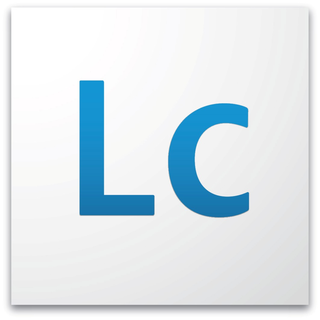The Portable Document Format (PDF) is a file format developed by Adobe in the 1990s to present documents, including text formatting and images, in a manner independent of application software, hardware, and operating systems. Based on the PostScript language, each PDF file encapsulates a complete description of a fixed-layout flat document, including the text, fonts, vector graphics, raster images and other information needed to display it. PDF was standardized as ISO 32000 in 2008, and no longer requires any royalties for its implementation.
Extensible Markup Language (XML) is a markup language that defines a set of rules for encoding documents in a format that is both human-readable and machine-readable. The World Wide Web Consortium's XML 1.0 Specification of 1998 and several other related specifications—all of them free open standards—define XML.
In computing, the term Extensible Stylesheet Language (XSL) is used to refer to a family of languages used to transform and render XML documents.
XSLT is a language for transforming XML documents into other XML documents, or other formats such as HTML for web pages, plain text or XSL Formatting Objects, which may subsequently be converted to other formats, such as PDF, PostScript and PNG. XSLT 1.0 is widely supported in modern web browsers.
DocBook is a semantic markup language for technical documentation. It was originally intended for writing technical documents related to computer hardware and software but it can be used for any other sort of documentation.
The Document Style Semantics and Specification Language (DSSSL) is an international standard developed to provide stylesheets for SGML documents.

Adobe FrameMaker is a document processor designed for writing and editing large or complex documents, including structured documents. It was originally developed by Frame Technology Corporation, which was bought by Adobe.

Typesetting is the composition of text by means of arranging physical types or the digital equivalents. Stored letters and other symbols are retrieved and ordered according to a language's orthography for visual display. Typesetting requires one or more fonts. One significant effect of typesetting was that authorship of works could be spotted more easily, making it difficult for copiers who have not gained permission.
The Organization for the Advancement of Structured Information Standards (OASIS) is a global nonprofit consortium that works on the development, convergence, and adoption of open standards for security, Internet of Things, energy, content technologies, emergency management, and other areas.
XSL-FO is a markup language for XML document formatting that is most often used to generate PDF files. XSL-FO is part of XSL, a set of W3C technologies designed for the transformation and formatting of XML data. The other parts of XSL are XSLT and XPath. Version 1.1 of XSL-FO was published in 2006.
The Open Document Format for Office Applications (ODF), also known as OpenDocument, is a ZIP-compressed XML-based file format for spreadsheets, charts, presentations and word processing documents. It was developed with the aim of providing an open, XML-based file format specification for office applications.
Formatting Objects Processor is a Java application that converts XSL Formatting Objects (XSL-FO) files to PDF or other printable formats. FOP was originally developed by James Tauber who donated it to the Apache Software Foundation in 1999. It is part of the Apache XML Graphics project.
XFA stands for XML Forms Architecture, a family of proprietary XML specifications that was suggested and developed by JetForm to enhance the processing of web forms. It can be also used in PDF files starting with the PDF 1.5 specification. The XFA specification is referenced as an external specification necessary for full application of the ISO 32000-1 specification. The XML Forms Architecture was not standardized as an ISO standard, and has been deprecated in PDF 2.0.
Single-source publishing, also known as single-sourcing publishing, is a content management method which allows the same source content to be used across different forms of media and more than one time. The labor-intensive and expensive work of editing need only be carried out once, on only one document; that source document can then be stored in one place and reused. This reduces the potential for error, as corrections are only made one time in the source document.
Adobe LiveCycle Designer is a forms authoring tool published by Adobe Systems, intended as a one-stop design tool to render XML forms as PDF or HTML files.
PDF/A is an ISO-standardized version of the Portable Document Format (PDF) specialized for use in the archiving and long-term preservation of electronic documents. PDF/A differs from PDF by prohibiting features unsuitable for long-term archiving, such as font linking and encryption. The ISO requirements for PDF/A file viewers include color management guidelines, support for embedded fonts, and a user interface for reading embedded annotations.

Adobe LiveCycle Enterprise Suite (ES4) is a service-oriented architecture Java EE server software product from Adobe Systems used to build applications that automate a broad range of business processes for enterprises and government agencies. LiveCycle ES4 is an enterprise document and form platform that allows capturing and processing information, delivering personalized communications, and protecting and tracking sensitive information. It is used for purposes such as account opening, services and benefits enrollment, correspondence management, request for proposal processes, and other manual based workflows. LiveCycle ES4 incorporates new features with a particular focus on mobile devices. LiveCycle applications also function in both online or offline environments. These capabilities are enabled through the use of Adobe Reader, HTML/PhoneGap and the Flash Player clients to reach desktop computers and mobile devices.
The following is a comparison of e-book formats used to create and publish e-books.
Advanced Content provides interactivity in the HD DVD optical disc format.
Antenna House Formatter is a proprietary software program that uses either XSL-FO or Cascading Style Sheets (CSS) to convert XML and HTML documents into PDF, SVG, INX, MIF, XPS, text, and Microsoft Word formats


